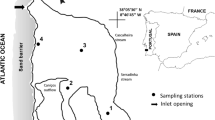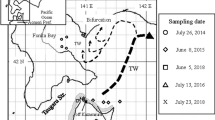Abstract
The age of Japanese eels (Anguilla japonica) is often estimated from otoliths, but this method has not been fully validated, particularly in tropical areas where the annulus in otolith is considered to be less distinct than in temperate areas. To validate the annuli in Japanese eel otoliths from southern Taiwan, known-age (2 year-old) cultured eels from an eel farm and wild eels from Kao-Ping River were collected. It was found that 26 out of 31 cultured eels (83.9%) showed two clear annuli and the remained 5 eels showed either one or three annuli. The mean (± SD) age of the cultured eels was 1.97 ± 0.4 years. Meanwhile, a clear peak in the mean monthly marginal increment ratio of the otolith in wild yellow and silver eels occurred once a year during winter (November to March). The annual deposition of presumed annuli in otoliths of Japanese eel was validated and the age and growth rate estimation for Japanese eels in the tropical southern Taiwan is deemed feasible. The growth rate of cultured eels was significantly faster than that of wild eels, but it did not differ significantly between sexes for wild silver, yellow or cultured eels. The von Bertalanffy Growth Function parameters (K, \(L_\infty \) and t 0 ) of the wild eels were estimated as 0.114 ± 0.028 year−1, 1178 ± 171 mm and −0.8 ± 0.2 years, respectively.




Similar content being viewed by others
References
Beamish RJ, McFarlane GA (1983) The forgotten requirement for age validation in fisheries biology. Trans Am Fish Soc 112:735–743 doi:10.1577/1548-8659(1983)112<735:TFRFAV>2.0.CO;2
Berg R (1985) Age determination of eels Anguilla anguilla (L.): comparison of field data with otolith ring patterns. J Fish Biol 26:537–544 doi:10.1111/j.1095-8649.1985.tb04294.x
Brouwer SL, Griffiths MH (2004) Age and growth of Argyrozona argyrozona (Pisces: Sparidae) in a marine protected area: an evaluation of methods based on whole otoliths, sectioned otoliths and mark-recapture. Fish Res 67:1–12 doi:10.1016/j.fishres.2003.08.007
Caldow C, Wellington GM (2003) Patterns of annual increment formation in otoliths of pomacentrids in the tropical western Atlantic: implication for population age-structure examination. Mar Ecol Prog Ser 265:185–195 doi:10.3354/meps265185
Campana SE (2001) Accuracy, precision and quality control in age determination, including a review of the use and abuse of age validation methods. J Fish Biol 59:197–242 doi:10.1111/j.1095-8649.2001.tb00127.x
Campana SE, Thorrold SR (2001) Otolith, increments, and elements: key to a comprehensive understanding of fish population? Can J Fish Aquat Sci 58:30–38 doi:10.1139/cjfas-58-1-30
Chen PH (2005) Distribution, growth and reproduction of splendid ponyfish, Leiognathus splendens (Cuvier 1829) in the coastal waters off southern Taiwan. Master Thesis. National Sun Yat-sen University, Kaohsiung, Taiwan
Chen MH, Chen CY, Chen PH, Wen TC (2007) Reproduction of the splendid ponyfish, Leiognathus splendens, in the mouth of Kao-Ping River (in Chinese). Poster presented in 2007 Taiwan Geosciences Assembly, Ocean Science Poster Section, PP-633, Acer Aspire Park, Longtan, Taoyuan country, Taiwan, 15–18 May 2007
Cheng PW, Tzeng WN (1996) Timing of metamorphosis and estuarine arrival across the dispersal range of the Japanese eel Anguilla japonica. Mar Ecol Prog Ser 113:89–96
Chu YW, Han YS, Wang CH, You CF, Tzeng WN (2006) The sex-ratio reversal of the Japanese eel Anguilla japonica in the Kaoping River of Taiwan: the effect of cultured eels and its implication. Aquaculture 261:1230–1238 doi:10.1016/j.aquaculture.2006.09.014
Deelder CL (1981) On the age and growth of cultured eels, Anguilla anguilla (Linnaeus, 1758). Aquaculture 26:13–22 doi:10.1016/0044-8486(81)90106-X
Dwyer KS, Walsh SJ, Campana SE (2003) Age determination, validation and growth of Grand Bank yellowtail flounder (Limanda ferrugunea). ICES J Mar Sci 60:1123–1138 doi:10.1016/S1054-3139(03)00125-5
Francis RICC (1990) Back-calculation of fish length: a critical review. J Fish Biol 36:833–902 doi:10.1111/j.1095-8649.1990.tb05636.x
Graynoth E (1999) Improved otolith preparation, ageing and back-calculation techniques for New Zealand freshwater eels. Fish Res 42:137–146 doi:10.1016/S0165-7836(99)00029-6
Guan R, Wang X, Ke G (1994) Age and growth of eels Anguilla japonica in a Chinese River. J Fish Biol 45:653–660 doi:10.1111/j.1095-8649.1994.tb00931.x
Gutreuter S (1987) Considerations for estimation and interpretation of annual growth rates. In: Summerfelt RC, Hall GE (eds) Age and growth of fish. Iowa State University Press, USA, pp 115–126
Han YS, Tzeng WN (2006) Use of the sex ratio as a means of resources assessment for the Japanese eel Anguilla japonica: a case study in the Kaoping River of Taiwan. Zool Stud 45:255–263
Han YS, Tzeng WN, Huang YS, Liao IC (2001) Silvering in the eel: changes in morphology, body fat content and gonadal development. J Taiwan Fish Res 9:119–127
Han YS, Liao IC, Huang YS, He JT, Chang CW, Tzeng WN (2003) Synchronous changes of morphology and gonadal development of silvering Japanese eel Anguilla japonica. Aquaculture 219:783–796 doi:10.1016/S0044-8486(02)00578-1
Jessop BM, Shiao JC, Tzeng WN (2004) Variation in the annual growth, by sex and migration history, of silver American eels Anguilla rostrata. Mar Ecol Prog Ser 272:231–244 doi:10.3354/meps272231
Lessa R, Santana FM, Duarte-Neto P (2006) A critical appraisal of marginal increment analysis for assessing temporal periodicity in band formation among tropical sharks. Environ Biol Fishes 77:309–315 doi:10.1007/s10641-006-9111-7
Lin YJ, Tzeng WN (2008) Effects of shrimp net and cultured eels on the wild population of Japanese eel Anguilla japonica in the Kao-Ping River, Taiwan. J Fish Soc Taiwan 35:61–73
Longhurst AR, Pauly D (1987) Ecology of tropical oceans. Academic, London
Michaud M, Dutil JD, Dodson JJ (1988) Determination of the age of young American eels, Anguilla rostrata, in fresh water, based on otolith surface area and microstructure. J Fish Biol 32:179–189 doi:10.1111/j.1095-8649.1988.tb05351.x
Morales-Nin B (1989) Growth determination of tropical marine fishes by means of otolith interpretation and length frequency analysis. Aquat Living Resour 2:241–253 doi:10.1051/alr:1989029
Morales-Nin B, Panfili J (2005) Seasonality in the deep sea and tropics revisited: what can otolith tell us? Mar Freshw Res 56:585–598 doi:10.1071/MF04150
Oliveira K (1996) Field validation of annular growth rings in the American eel Anguilla rostrata, using tetracycline-marked otolith. Fish Bull (Wash D C) 94:186–189
Oliveira K (1999) Life history characteristics and strategies of American eel, Anguilla rostrata. Can J Fish Aquat Sci 56:795–802 doi:10.1139/cjfas-56-5-795
Okamura A, Zhang H, Mikawa N, Kotake A, Yamada Y, Utoh T et al (2007) Decline in non-native freshwater eels in Japan: ecology and future perspectives. Environ Biol Fishes 81:347–358 doi:10.1007/s10641-007-9205-x
Pantulu VR (1956) On the biology of the Indian fresh-water eel, Anguilla bengalensis Gray. Proc Natl Inst Sci India 22:259–280.
Pauly D (1998) Tropical fishes: patterns and propensities. J Fish Biol 53(Suppl A):1–17
Pease BC, Reynolds DP, Walsh CT (2003) Validation of otolith age determination in Australian longfinned river eels, Anguilla reinhardtii. Mar Freshw Res 54:995–1004 doi:10.1071/MF03040
Poole WR, Reynold JD (1996) Growth rate and age at migration of Anguilla anguilla. J Fish Biol 48:633–642
Quinn JT II, Deriso RB (1999) Quantitative Fish Dynamics. Oxford University Press, New York
Schramm HL Jr (1989) Formation of annuli in otoliths of bluegills. Trans Am Fish Soc 118:546–555 doi:10.1577/1548-8659(1989)118<0546:FOAIOO>2.3.CO;2
Svedäng H, Wickström H, Reizenstein M, Holhren K, Florenius P (1998) Accuracy and precision in eel age estimation, using otolith of known and unknown age. J Fish Biol 53:456–464
Tesch FW (2003) The eel, 3rd edn. Blackwell Science, UK
Thibault I, Dodson JJ, Caron F, Tzeng WN, Iizuka Y, Shiao JC (2007) Facultative catadromy in American eels: testing the conditional strategy hypothesis. Mar Ecol Prog Ser 344:219–229 doi:10.3354/meps06944
Tsukamoto K (2006) Spawning of eels near a seamount: tiny transparent larvae of the Japanese eel collected in the open ocean reveal a strategic spawning site. Nature 493:929 doi:10.1038/439929a
Tsukamoto K, Arai T (2001) Facultative catadromy of the eel Anguilla japonica between freshwater and seawater habitats. Mar Ecol Prog Ser 220:265–276 doi:10.3354/meps220265
Tzeng WN, Wu HF, Wickstrom H (1994) Scanning electro microscopic analysis of annulus microstructure in otolith of European eel, Anguilla anguilla. J Fish Biol 45:479–492 doi:10.1111/j.1095-8649.1994.tb01330.x
Tzeng WN, Lin HR, Wang CH, Xu SN (2002) Differences in size and growth rates of male and female migrating Japanese eels in Pearl River, China. J Fish Biol 57:1245–1253 doi:10.1111/j.1095-8649.2000.tb00484.x
Vøllestad LA (1985) Age determination and growth of yellow eels, Anguilla anguilla (L.), from a brackish water, Norway. J Fish Biol 26:521–525 doi:10.1111/j.1095-8649.1985.tb04292.x
Williams AJ, Davies CR, Mapstone BD (2005) Variation in the periodicity and timing of increment formation in red throat emperor (Lethrinus miniatus) otoliths. Mar Freshw Res 56:529–553 doi:10.1071/MF04129
Acknowledgements
This study was financially supported by the National Science Council of R.O.C. (NSC94-2313-B-002-070). We thank colleagues in the Laboratory of Fisheries Biology, Institute of Fisheries Science, National Taiwan University, S-L Chang and his colleagues in the Division of Biotechnology, Fisheries Research Institute of Taiwan for sampling arrangement and help with field work. We also thank local fishermen for their cooperation during specimen collection and for providing information about the eel fishery in Kao-Ping River. We would like to express special thanks to B. Jessop, Department of Fisheries and Ocean, Bedford Institute of Oceanography, Canada, and two anonymous reviews for helpful comments on an early draft of this manuscript.
Author information
Authors and Affiliations
Corresponding author
Rights and permissions
About this article
Cite this article
Lin, YJ., Tzeng, WN. Validation of annulus in otolith and estimation of growth rate for Japanese eel Anguilla japonica in tropical southern Taiwan. Environ Biol Fish 84, 79–87 (2009). https://doi.org/10.1007/s10641-008-9391-1
Received:
Accepted:
Published:
Issue Date:
DOI: https://doi.org/10.1007/s10641-008-9391-1




